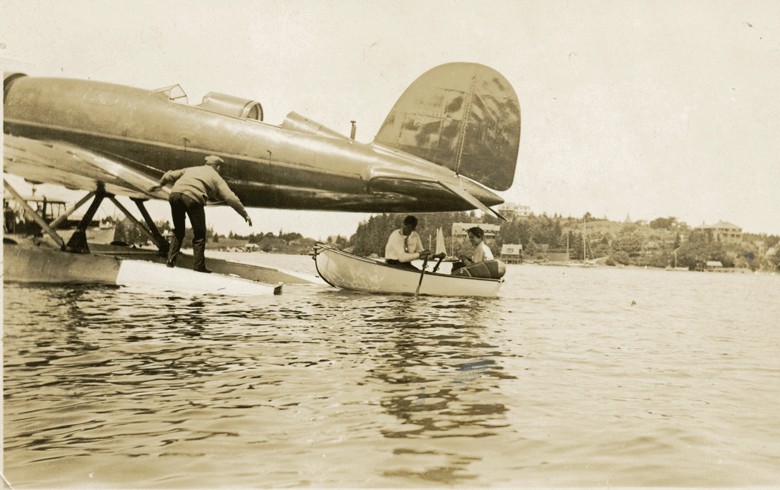This story first appeared on the website Maine Island Living and is reprinted here by permission.
“An hour and a half before they took off, you could have walked across the Thoroughfare on the rowboats,” wrote Ellen Pratt (1906-2000) of the day Anne Morrow Lindbergh and Charles Lindbergh left North Haven on what became the Great Circle Route to the Orient.
It was July 30, 1931, described by Pratt as “a perfectly beautiful day.” Aviator hero Lindbergh and his co-pilot-navigator-radio operator wife Anne had just spent a respite at her family’s summer home surrounded by friends and relatives.
The trip originated in Washington, D.C., but officially started in New York. For Anne and her fellow islanders, the true beginning of the journey was firmly anchored in the Fox Island Thoroughfare.
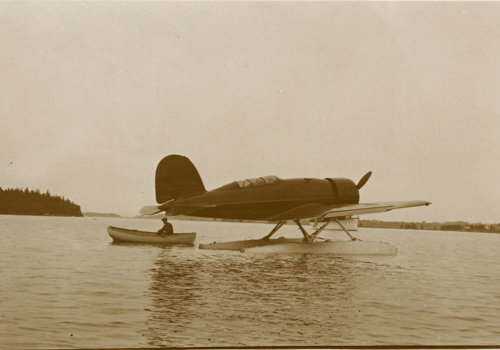
Just about every North Havener had a role, either taking a shift guarding the Lockheed Sirius 8 plane purchased two years earlier for $22,825, herding reporters so they wouldn’t overrun the plane or its pilots, providing last-minute supplies, or simply witnessing such a vivid moment in global aviation. Samuel H. Beverage, avid model plane builder and then age 14, recalls how his very next project was a Lockheed Sirius.
“I forget to whom I sold it. My usual price was 50 cents which was quite a lot of money in 1931,” he remembers.
On takeoff, the plane swooped down low at Seal Cove “and flew down the Thoroughfare very low,” Pratt remembered. “Every rowboat was jammed and everyone was standing, crying, clapping, screaming. I still remember my own tears—it was a very exciting, moving moment in all our lives.”
“I still remember my own tears—it was a very exciting, moving moment in all our lives.”
—Ellen Pratt
North Haven was a treasured place for Anne Morrow Lindbergh, filled with childhood memories, and it became the base from which she copiloted her second record-setting flight. According to her sister Constance Morrow Morgan (1913-1995), Anne worked the hardest on writing the North Haven chapter for North to the Orient, published in 1935. The book became a bestseller, won the National Book Award, and was the first of several literary triumphs for the pilot-writer-mother.
Of North Haven, she writes: “The visit was an emotional springboard, and, as such, was marked with an importance far greater than its brief hours might warrant.” Of their departure she adds, “The day was hard and clear and bright, like the light slanting off a white farmhouse. The island falling away under us as we rose in the air lay still and perfect, cut out in starched clarity against a dark sea. I had the keenest satisfaction in embracing it all with my eye. It was mine as though I held it, an apple in my hand.”
Little wonder she held the island so lovingly as they flew north: The couple’s one-year-old son, Charles Jr., was ensconced in her family’s white farmhouse by the sea.
The Lindberghs flew across Canada to Russia, then on to Japan and China. The distances made it imperative for there to be two pilots. Anne’s navigator and radio operator roles were key to the success and safety of the flight.
Anne was just 25 when she flew the 10,000 miles to China in a tiny plane, her husband Charles 29.
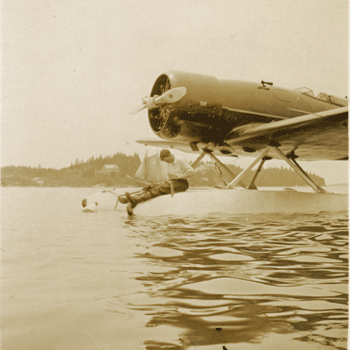
In 1931 and later pioneering flights, Anne continued as copilot, navigator, radio operator, flight memoir writer, natural diplomat, linguist, as well as what she considered her most important roles: mother of six children and wife. She was even an inventor, having the idea of sliding cockpit covers that ultimately became an industry standard.
Anne was the first licensed female glider pilot as well, probably as a safety measure so she could glide the aircraft to an emergency landing if necessary.
As recounted in North to the Orient, after departing from North Haven the couple flew to Ottawa, during which Anne had what she describes as her “first successful day” on the radio.
That evening Charles mapped their route across Canada with the help of concerned colleagues. Anne describes the scene in signature candor:
“An absorbed group of aviators, travelers, explorers, meteorologists, surveyors, and scientists—men who knew Northern Canada as no other group in the world—stood around him arguing.“ When one of the experts said he would not take his own wife on a particular leg they were considering, Lindbergh reminded him that his wife was “crew,” a professional confidence Anne was “even more flattered” by than the chivalry expressed by the expert advisor.
Charles was fierce about safety. Even so, since they were in an infant industry, danger was inherent, stalking them constantly and most often in the form of fog.
While the trip took them to 18 more locations, Anne focused on key stops in her writing, starting with Canada’s Baker Lake, “a gray glassy lake, bounded by gray bleak shores a little higher than the marshes.” From Baker Lake they followed the Canadian shore along Amundsen Gulf on the Beaufert Sea, putting them in a river near Aklavik.
Next they landed in a lagoon at Point Barrow, “the bleak northern top of Alaska,” after dancing dangerously with thick, incessant fog. From there they arrived at the mining town of Nome, another ocean landing during which they raced the darkness to seek an unknown harbor on the Bering Coast.
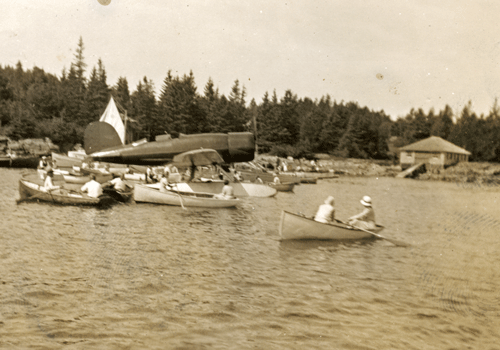
On to Kamchatka, Russia after flying over the tiny island of Karaginski, where Anne was able to communicate in French rather than the beginner Russian she had learned in preparation for the trip. After soaring along the chain of islands that connect the Kamchatka Peninsula to the big northern Japanese island of Hokkaido, more fog banks haunted the skies, as if hunting them down.
Such weather required an emergency landing in open ocean after multiple, frightening, failed attempts at a Buroton Bay landing.
“Does he really think I enjoyed his game of tobogganing down volcanoes?” laments Anne that day.
Despite their rough landing in choppy seas, Anne’s subsequent experiences in Japan were worthwhile on many levels. Morgan explains that while Anne was fascinated by all the places they went and the people they met, the philosophies and aesthetics of Japan would have a lasting impact on Anne’s life and writing.
Next they landed in a lagoon at Point Barrow, “the bleak northern top of Alaska.”
She writes about Osaka next, a city made particularly memorable when her husband discovered a “good-sized boy of 18” hiding in the forward cockpit. Anne worried about what would happen to the young stowaway, a fellow unhappy at home and hoping to land himself in the United States, compliments of the Lindberghs. The couple was, of course, en route to China.
CHINA AT LAST
On Sept. 19, 1931 the Lindberghs arrived at Nanking (Nanjing), then capital of China, landing safely on Lotus Lake, where Anne notes, “The flooded waters stretched to the foot of the wall, like a medieval moat.” The couple immediately donated their energy, skills, and equipment to map an additional 8,000 square miles of devastation for China’s National Flood Relief Commission.
Anne would pilot while Charles took photographs and surveyed the Yellow River (Huang He) flood zone, the most destructive in China’s history. The Lindberghs’ Sirius was the only plane around that could fly such distances, enabling them to provide these critically important visual records from which officials planned relief strategy.
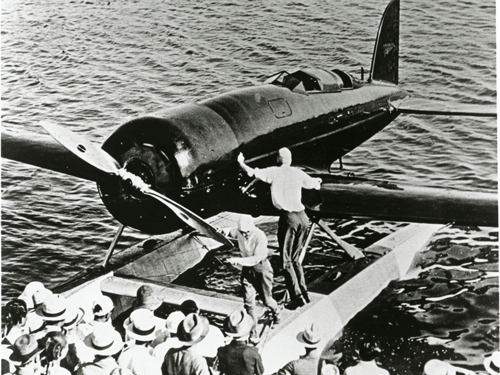
To make room for doctors delivering medicine, Charles also flew to the struggling town of Hinghwa without Anne. Desperate, hungry flood victims perilously tried to board the plane from their poled sampans, requiring Charles’s selective use of his pistol—warning shots in the air—to prevent the plane from getting overrun and likely damaged.
Despite their success with ocean and lake anchorages, the Lindberghs fared badly in the Yangtze River farther inland in Hankow (present day Wuhan). They had flown there from Nanking before what was to be their last trip over the flood—an extremely important mission bringing a doctor to the ravaged regions. Known for its strong currents and dirty water, the swollen river was particularly turbulent after the rains. Concerned for the plane’s safety, the captain of the British carrier H.M.S. Hermes hoisted the Lindberghs’ Sirius onboard.
A subsequent botched attempt at lowering the plane back into the water resulted in near tragedy for the pilots and a pile of people in a small boat pulled into the dramatic scene by the current. Anne and Charles were forced to jump from the plane as a wing dipped into the rushing river, the cable connecting them to the giant carrier too taut to release the aircraft. Thankfully, the doctor was not yet onboard as a precaution.
A team effort involving an American gunboat and Charles boarding his upside-down, partially submerged plane to attach ropes to the accessible wing and propeller resulted in gaining some control.
Because of the severity of damage to the aircraft, the Lindberghs would have to take a ship home to America. News of the mishap reached family and friends on North Haven and elsewhere in the country quickly, causing concern and disappointment.
To make matters worse, Anne’s father, Ambassador Dwight W. Morrow, unexpectedly passed away before they could return. North Haven resident Lewis Haskell sums up the collective feeling well: “Later we heard that they got in trouble in China in the floods that were going on there, fell in the Yangtze River, and got the plane all banged up. People worried. It seemed a terrible comedown that they took a boat home. He should have flown home.”
The Lindberghs did not stay grounded for long, and by 1933 they installed a more powerful engine in the Sirius in preparation for an Atlantic survey flight. Again departing from the Fox Island Thoroughfare, this pioneering trip took them to Labrador, Iceland, Greenland, Europe, and then on to Africa, South America, and islands between. Ten days of this journey is described in vivid detail in Anne’s Listen! The Wind (1938).
In that 1931 flight to the Orient the Lindberghs enhanced U.S.-China relations, helped those stricken by the massive flood there, and represented the very best of youth and promise while capturing the imagination of the world.
And long before the feminist movement took hold in the U.S., Anne Morrow Lindbergh broke glass ceilings neither she nor Charles acknowledged even as she flew through them.
Observes Morgan of the Lindbergh’s copiloted flights: “The newsreel footage of a married couple working in such equality in a professional situation would have a huge impact on the American imagination of how men and women might work together.”
As so aptly stated by island resident Garrison Norton in a letter to the North Haven Historical Society decades ago, “Charles and Anne staggered the world between them.”
Kate Hotchkiss is the author of the historical novel On Harbor’s Edge. She lives on North Haven. She extends thanks and acknowledgement to the North Haven Historical Society and its supporters, Margaret Eiluned Morgan, Reeve Lindbergh and her book Under a Wing Ne(1998), China historian Steven Hansberger, The Smithsonian Air and Space Museum, “Lindbergh’s Chart Flood Area in China” by New York Times journalist Hallett Abend, Yale University’s chief research archivist and Lindbergh historian Judith Schiff, and Anne Morrow Lindbergh’s North to the Orient and Listen! The Wind.
